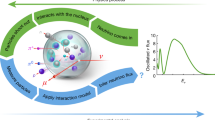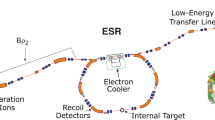Abstract
Non-radiative transitions in nuclear capture reactions between light nuclei play a relevant role in stellar nuclear astrophysics, where nuclear processes occur at typical energies from tens to hundreds of keV. At higher energies, instead, the E0 contributions may be shadowed by more intense transitions. The experimental study of E0 transitions requires a specific detection setup, able to uniquely identify events where an electron-positron pair is produced. A compact ΔE-E charged-particle spectrometer based on two silicon detectors has been designed to be installed in the jet gas target chamber of the recoil mass separator ERNA (European Recoil separator for Nuclear Astrophysics) at the CIRCE laboratory of Caserta, Italy. The detector design, its performances and the first foreseen applications are described.
Similar content being viewed by others
Explore related subjects
Discover the latest articles and news from researchers in related subjects, suggested using machine learning.References
D. Schürmann et al., Eur. Phys. J. A 26, 301 (2005).
A. Di Leva et al., Phys. Rev. Lett. 102, 232502 (2009).
A. Di Leva et al., Phys. Rev. Lett. 103, 159903 (2009).
K.A. Snover, A.E. Hurd, Phys. Rev. C 67, 055801 (2003).
G. Baur, K.A. Snover, S. Typel, Phys. Rev. C 75, 058801 (2007).
D. Rogalla et al., Nucl. Instrum. Methods A 437, 266 (1999).
D. Rogalla et al., Eur. Phys. J. A 6, 471 (1999).
D. Rogalla et al., Nucl. Instrum. Methods A 513, 573 (2003).
L. Gialanella et al., Nucl. Instrum. Methods A 522, 432 (2004).
D. Schürmann et al., Nucl. Instrum. Methods A 531, 428 (2004).
G. Imbriani et al., Astrophys. J. 558, 903 (2001).
I. Dominguez, P. Höflich, Astrophys. J. 528, 854 (2000).
D. Schürmann et al., Phys. Lett. B 711, 35 (2012).
C. Matei et al., Phys. Rev. Lett. 97, 242503 (2006).
D. Schürmann et al., Phys. Lett. B 703, 557 (2011).
K.H. Hahn, K.H. Chang, T.R. Donoghue, B.W. Filippone, Phys. Rev. C 36, 892 (1987).
R. Kunz et al., Nucl. Phys. A 621, 149c (1997).
U. Hager et al., Phys. Rev. C 84, 022801 (2011).
O. Straniero, private communication.
D. Baye, P. Descouvemont, Phys. Rev. C 38, 5 (1988).
S.D. Bloom, Phys. Rev. 88, 312 (1952).
J.L. Wood et al., Nucl. Phys. A 651, 323 (1999).
C.P. Montoya et al., Nucl. Instrum. Methods A 334, 437 (1993).
W.S. Freeman et al., Nucl. Instrum. Methods 204, 445 (1983).
W. Michaelis, D. Lange, Nucl. Instrum. Methods 58, 349 (1968).
L. Landau, J. Phys. USSR 8, 201 (1944).
S. Agostinelli et al., Nucl. Instrum. Methods A 506, 250 (2003).
D.R. Tilley, C.M. Cheves, J.H. Kelley, S. Raman, H.R. Weller, Nucl. Phys. A 636, 247 (1998).
K. Spyrou et al., Z. Phys. A 357, 283 (1997).
Y. Kalambet et al., J. Chemom. 25, 352 (2011).
A. Gavron, Phys. Rev. C 21, 230 (1980).
O.B. Tarasov, D. Bazin, Nucl. Instrum. Methods B 266, 4657 (2008).
Author information
Authors and Affiliations
Corresponding author
Additional information
Communicated by N. Kalantar-Nayestanaki
Rights and permissions
About this article
Cite this article
Guerro, L., Di Leva, A., Gialanella, L. et al. A pair spectrometer for nuclear astrophysics experiments. Eur. Phys. J. A 50, 171 (2014). https://doi.org/10.1140/epja/i2014-14171-1
Received:
Revised:
Accepted:
Published:
DOI: https://doi.org/10.1140/epja/i2014-14171-1




